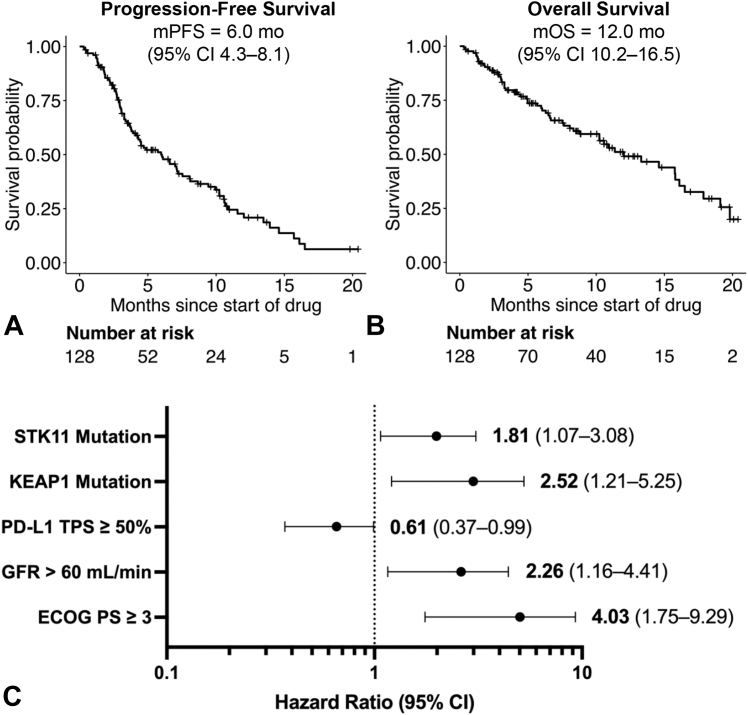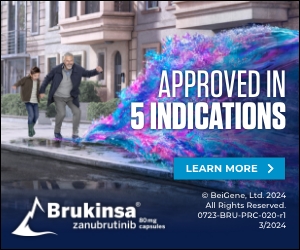
Click to Enlarge: Survival analysis of veterans with KRAS G12C-mutated NSCLC treated with sotorasib. (A) PFS and (B) OS of veterans with KRAS G12C-mutated NSCLC treated with sotorasib. (C) Forest plot of factors associated with PFS based on univariable analysis, with corresponding hazard ratio in bold and 95% CI in parentheses. 95% CI, 95% confidence interval; ECOG PS, Eastern Cooperative Oncology Group performance status; GFR, glomerular filtration rate; KEAP1, Kelch-like ECH-associated protein 1; mo, months; mOS, median overall survival; mPFS, median progression-free survival; PD-L1 TPS, programmed death ligand-1 tumor proportion score; STK11, serine/threonine kinase 11. Source: JTO Clinical and Research Reports
DURHAM, NC — Three years ago, based on the CodeBreak100 trial, the Food and Drug Administration granted accelerated approval to the KRAS G12C inhibitor sotorasib for treating advanced non-small cell lung cancer in the second line or later.
VA researchers noted, however, that “data on the real-world efficacy and safety of sotorasib, and to its optimal dose, remain limited.” To remedy that, a study team led by the Durham VA Healthcare System and Duke University retrospectively identified patients treated with sotorasib for NSCLC through the VHA’s Corporate Data Warehouse. Chart review was used to obtain survival, response, and toxicity data in the research which also involved the Ann Arbor, MI, VAMC and the VA North Texas Healthcare System in Dallas.
The results indicated that, among the 128 patients treated with sotorasib through the VHA, objective response rate was 34%, progression-free survival (PFS) six months and overall survival 12 months.
“Similar PFS was observed among the 16 patients who received frontline sotorasib without any prior systemic therapy for NSCLC,” the authors pointed out in JTO Clinical and Research Reports. “Toxicity leading to sotorasib interruption or dose reduction occurred in 37% of patients, whereas sotorasib discontinuation for toxicity occurred in 25%.”1
The researchers added that sotorasib dose reduction was associated with substantially improved progression-free survival and overall survival.
The real-world study concluded that “the observed efficacy of sotorasib was similar to the results of CodeBreaK100. Patients who received frontline sotorasib had similar PFS to our overall cohort, suggesting that first-line sotorasib monotherapy may benefit patients who are not eligible for chemotherapy.”
The study team added, however, that it was common for toxicities leading to sotorasib interruption, dose reduction, or discontinuation to occur. They advised, however, “Sotorasib dose reduction was associated with improved survival, suggesting that sotorasib dose reduction may not compromise efficacy.”
Background information in the article explained how KRAS mutations are among the most common drivers of NSCLC. In fact, the most common mutation subtype, KRAS G12C, occurs in 13% of lung adenocarcinomas.
The CodeBreaK100 trial found that sotorasib was associated with an objective response rate (ORR) of 37%, median progression-free survival (PFS) of 6.8 months, and median overall survival (OS) of 12.5 months in patients with KRAS G12C-mutated advanced NSCLC who received at least one prior line of systemic therapy. In the phase III CodeBreaK200 study comparing sotorasib with docetaxel in the same population, sotorasib was associated with an ORR of 28.1%, median PFS of 5.6 months, and median OS of 10.6 months.
Tolerability Investigated
The current researchers pointed out that some concerns have been raised about the tolerability of sotorasib at the approved daily dose of 960 mg. Treatment-related adverse events (TRAEs) led to sotorasib interruption or dose reduction in 22.2% and sotorasib discontinuation in 7.1% of patients in the first trial and
sotorasib interruption in 36%, dose reduction in 15% and discontinuation in 10% of patients in the second.
The U.S. Food and Drug Administration issued a post-marketing requirement to compare 240 with 960 mg daily to determine the optimal dose of sotorasib and past studies comparing starting doses of 240 and 960 mg sotorasib daily found that 960 mg was associated with increased ORR and improved OS but also increased rates of serious TRAEs and sotorasib interruption or dose reduction.
The VA study sought to add to the information on the real-world efficacy and safety of sotorasib among veterans with advanced NSCLC, including the relationship between dose reduction and efficacy. Patients treated by the VHA tend to be less fit than the clinical trial participants, they noted.
“Our cohort was older than the CodeBreaK100 and CodeBreak200 cohorts, less fit, more likely male, and more likely Black or African American; 36 patients (28%) would not have been eligible for CodeBreaK100 based on performance status, renal function, or active CNS disease,” the VA researchers reported. “Despite this older and less fit cohort, the response rate of sotorasib in our retrospective analysis was similar to clinical trial results.
They added that, because response data were missing in 28% of this cohort, the true ORR was likely lower than 34%. “Although the KRAS G12C inhibitor adagrasib has intracranial activity, the CNS activity of sotorasib is less clear because patients with active untreated brain metastases were excluded from CodeBreaK100,” according to the study.
The study team advised that, although the approved starting dose of sotorasib is 960 mg daily, that dosage was found to be associated with greater toxicity, adding that the biologically optimal dose might be lower.
The researchers said they were surprised that patients in their cohort who required dose reduction had improved PFS and OS relative to patients who did not require dose reduction, which might be due to reduced toxicity at the lower dose. “Although we cannot exclude confounding factors owing to the retrospective study design, this result supports the possibility that a lower dose of sotorasib may not compromise efficacy. Given the greater toxicity associated with higher doses of sotorasib, lower starting doses of sotorasib may be appropriate in less fit patients,” they wrote.
- Zhou KI, Lin C, Tseng CL, Ramnath N, Dowell JE, Kelley MJ. Brief Report: Real-World Efficacy and Safety of Sotorasib in U.S. Veterans with KRAS G12C-Mutated NSCLC. JTO Clin Res Rep. 2024 Mar 26;5(5):100670. doi: 10.1016/j.jtocrr.2024.100670. PMID: 38746048; PMCID: PMC11090863.


